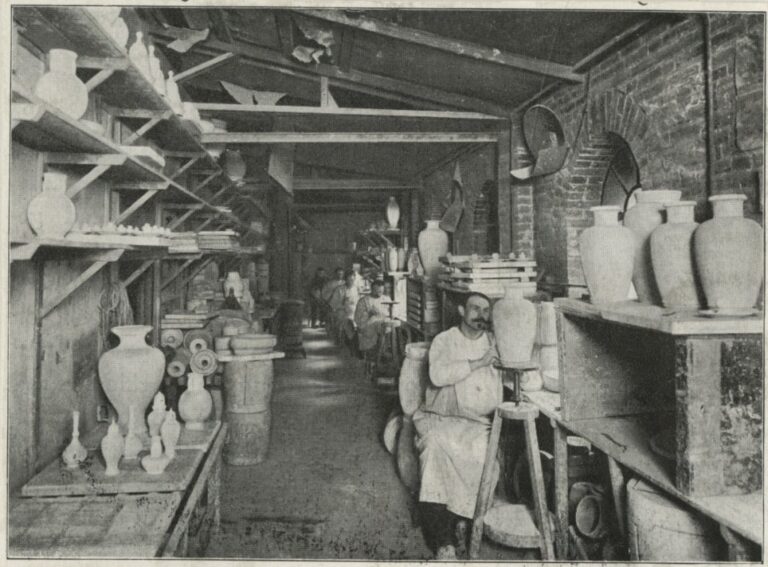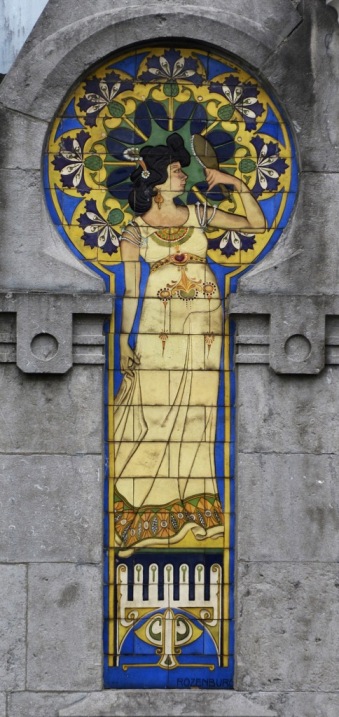You don’t have to go to a museum to see beautiful things. Personally, I love ceramics, and ceramic tiles can be found on house facades in many places in The Hague. Some of these tile panels were produced in a factory that once existed in The Hague, the “Haagsche Plateelbakkerij (Pottery) ‘Rozenburg’”.
Founder
The founder of the Rozenburg factory was a man with an impressive name: Wilhelm Wolff Freiherr van Gudenberg. He was the son of a German earthenware manufacturer and trained as a chemist. Around 1882 he lived in Delft, where he worked at the Porceleyne Fles ceramics factory and studied at the Polytechnic School (the forerunner of the Technical University).
In 1883, he moved to The Hague and rented an abandoned warehouse at Boekhorststraat 1. He had ovens installed and started his business with the name: “De N.V. ‘s-Gravenhaagsche Kunstaardewerkfabriek (Art earthenware manufacturer)”.
Rozenburg
Apparently, business went well, because residents in Boekhorststraat began to complain about the emission of smoke and soot. In 1885, the company moved to a place that was then on the outskirts of The Hague, at 216 Zuid-Binnensingel (the street name is now Buitenom). There, at the edge of the Westsingel canal, lay the dilapidated country estate Rozenburg and in 1887 the firm adopted this name.
Vases and tableware
Anyone who has ever visited the Kunstmuseum or The Mesdag Collection will be familiar with the beautiful vases and tableware produced by the Rozenburg factory. With unusual designs and beautiful painting in the Art Nouveau style. Theo Colenbrander and Jurriaan Kok are among the designers credited in the exhibits.
Rozenburg tile panels
You can also see Rozenburg products outside museums in the form of tile panels on building facades.
Some homeowners of the time gave their houses pretty names, which they wanted to display in an attractive way that often includeddecorative tile pictures. One such collection of Rozenburg tile pictures can be seen at the ‘Putruwiel’ villa at 17 Nieuwe Parklaan. This villa was built around 1905, a time when many large villas appeared in this part of The Hague.
Businesses and organisations used Rozenburg tile work to display their names, often with pictures representing their activities.
A fine example of such a tile picture can be found on the Fluwelen Burgwal. That was the location of the Algemeene Landsdrukkerij (State Printing Organization). At that time it was a governmental department. But apparently with enough money to have Rozenburg create an impressive tile picture for their new building in 1910. The organization moved out of the building in the 1960s.
The fashion house “De Duif” in the Venestraat commissioned a very beautiful tile tableau from Rozenburg to place on its already beautiful Art Nouveau façade.
Surprise
Unfortunately, in the course of time many tile panels have disappeared. Fortunately, however, sometimes during renovations or alterations there is a pleasant surprise.
In 2018, removal of a façade from 1957 revealed the original facade of the cinema Cinéma Américain, built in 1911-1912 to a design by architect M. Kuyper Czn (1881-1948). The design included beautiful decorations in natural stone and a tile panel with the name of the cinema. The newspaper “Het Vaderland” wrote on 1 February 1912 that “the theatre has been given a special cachet by its finish”. The owner of the building, Staedion Housing Association made a film (in Dutch) about the recent renovation.
This tile panel lost its function as early as 1915, when the building became the Thalia cinema. It remained so until 1972, when the cinemas in the Boekhorststraat were mainly known for a certain genre of films. In 1966, De Tijd/De Maasbode (then a Catholic newspaper) talked about “the dark corners in the Boekhorststraat where invariably films of unbridled violence and unbridled love were shown”. Which is a nice way to describe fight and sex films.
Rozenburg closure
Helaas is gebleken dat een fabriek niet alleen overeind blijft door mooie dingen te produceren. Er moet ook winst gemaakt worden. En dat lukte Rozenburg uiteindelijk niet. In 1917 was het al gedaan en moest het bedrijf sluiten.
Unfortunately, a factory does not stay afloat just by producing beautiful things. It also has to make a profit. And ultimately Rozenburg failed to do that. By 1917 it was all over and the company had to close its doors.
But fortunately, we can still enjoy the beautiful tile panels and other products from Rozenburg. I show you them during my Art Nouveau & Art Deco City walk or during my Art Nouveau Bicycle Tour.







